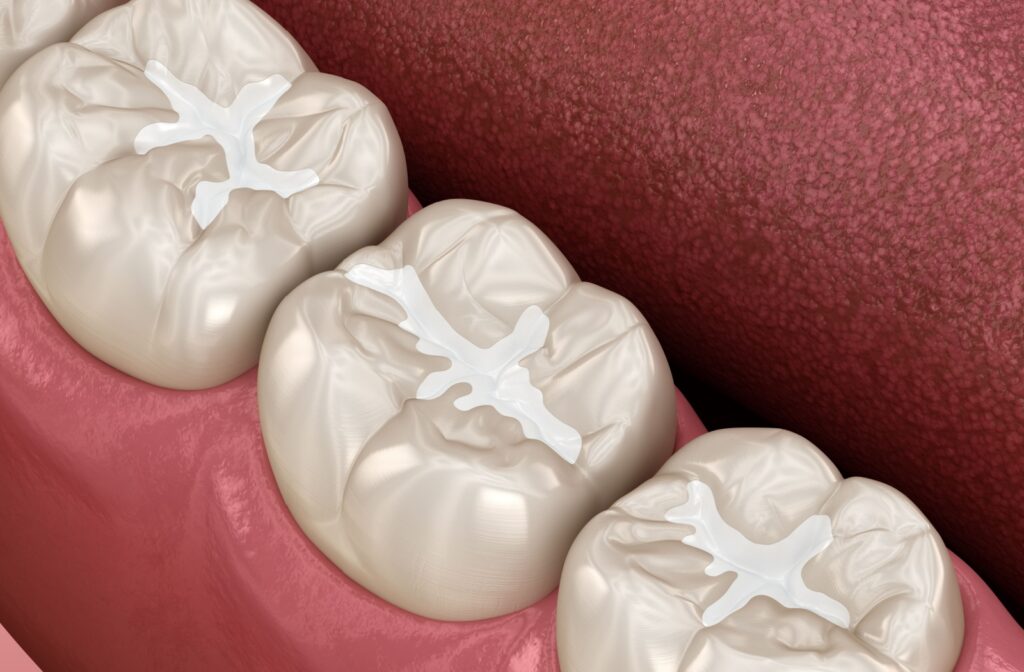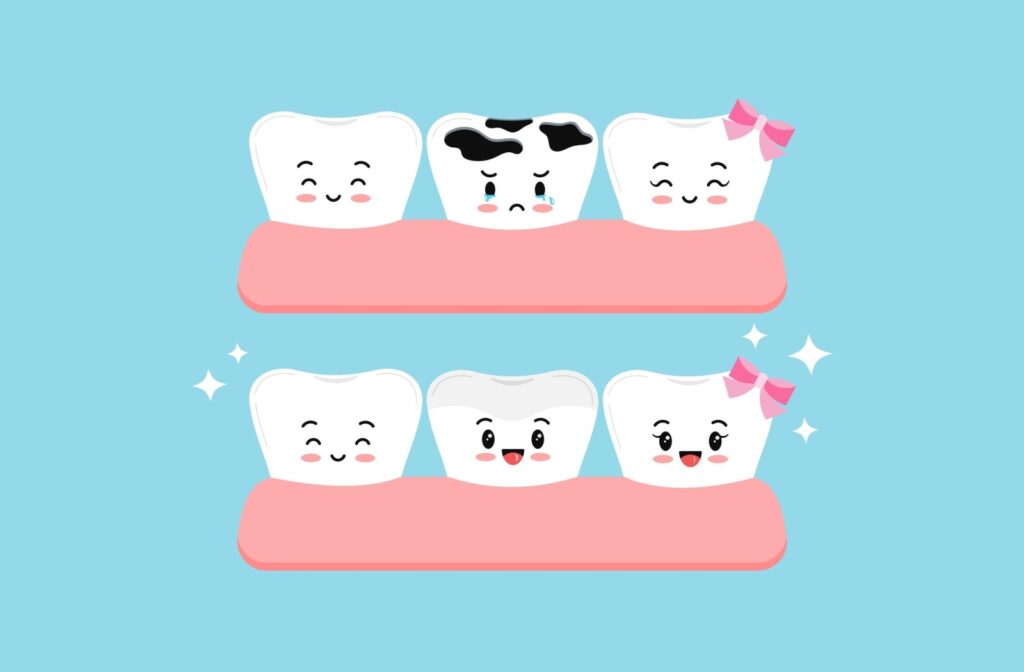As a parent, you’re always looking for ways to protect your child’s health and happiness, and their smile is a huge part of that. You probably know about brushing, flossing, and the importance of regular children’s dentistry check-ups (even if convincing your little one to brush sometimes feels like a nightly negotiation!). But there’s another helpful tool in the cavity-prevention kit—dental sealants. Our team at London Little Bites Dentistry is here to make your child’s oral health journey a positive one.
You might be curious about what they are and how they can support your child’s dental care routine. Dental sealants offer a simple and effective way to help guard your child’s teeth against cavities, especially on those hard-to-reach back molars. This guide will walk you through what you need to know about this protective treatment.
What Are Dental Sealants?
Dental sealants are thin, protective coatings that we paint onto the chewing surfaces of the back teeth—the molars and premolars. These teeth are the workhorses of the mouth, but their surfaces have tiny natural grooves and pits. These nooks and crannies are tricky for toothbrush bristles to clean properly, making them a popular hiding spot for food and plaque.
How Sealants Work
You can think of a sealant like a superhero’s raincoat for your child’s tooth. It smoothly covers all those deep grooves on the chewing surfaces where pesky cavities often decide to set up camp. This opaque barrier helps stop food particles and plaque from getting trapped and causing trouble.
A Safe & Simple Material
We use a safe, white-coloured plastic resin for sealants. It’s painted on as a liquid and then hardens in seconds to form a durable, protective layer. The whole process is very straightforward and comfortable for kids.
Benefits of Sealants for Your Child’s Teeth
Dental sealants are a fantastic proactive and preventative step you can take for your child’s oral health, almost like insurance for the teeth. They don’t replace brushing and flossing but work alongside them as a helpful teammate. This extra layer of defence can give you added peace of mind when it comes to your child’s smile.
A Barrier Against Food & Plaque
A sealant’s main job is to protect the most cavity-prone areas, those deep grooves on the back teeth we lovingly call “groovy teeth.”
For parents, we like to explain it this way: think of the tooth like a little mountain range. It’s easy to brush the tops of the mountains, but it’s much harder to clean deep down in the valleys. That’s where cavities love to hide.
So what do we do? We fill in the valleys! Sealants smooth out those tricky spots, making it easier to brush, and much harder for plaque and food to get stuck.
Support Good Brush Habits
When your child’s back teeth are covered with smooth sealants, they become much easier to clean. Your child’s toothbrush can actually do its job, instead of just skating over those tricky bumps. That’s a big win for little brushers who’d rather be doing anything else.
A Quick & Comfortable Process
Applying sealants is a quick and comfortable process, and no freezing is needed.
We do sometimes use a dental drill, but only very gently, to help prepare the tooth surface. It’s a light touch and doesn’t cause any discomfort. Most kids don’t even notice, especially once the ‘special blue light’ comes out to seal everything in place. (We call it our magic wand, and yes, it’s a fan favourite!)

When to Consider Dental Sealants
Timing really matters when it comes to sealants. After permanent molars first come in, their enamel continues to mature for about 2–3 years, and that’s when they’re most vulnerable to cavities.
That’s also the perfect window to apply a sealant. Placing it early gives the tooth added protection while the enamel finishes strengthening, helping stop decay before it starts.
The Right Age for Molars
Your child’s first permanent molars usually show up around age six, with the second set arriving around age 12. These are key times to chat with Dr. Lee about applying sealants. Protecting these brand-new teeth early can make a big difference for their future health.
Your Dentist’s Recommendation
Every child’s smile is unique, and so are their dental needs. A pediatric dentist can take a close look at your child’s teeth to see if sealants are a good option. We can check the shape of their molars and help you decide on the right preventive plan together.
The Sealant Application Process
We know that as a parent, it’s always helpful to know what to expect during a dental appointment for your child. The good news is that the process for applying sealants is simple, quick, and can be completed in just one short visit. As part of a comprehensive prevention program supported by the Canadian Dental Association, here are the four main steps to giving a tooth its protective shield.
- Clean & Dry The Tooth First, we give the tooth a thorough cleaning to make sure the surface is ready. Then we dry it completely and use small cotton rolls to keep it protected from saliva during the process.
- Prepare The Tooth Surface To get the tooth ready, we gently clean the grooves of the enamel using a dental drill, just in the deep grooves, and only for about 20 to 30 seconds. This step removes any debris, increases the surface area, and helps the sealant bond more securely to the enamel, kind of like priming a surface before painting.
- Paint On The Sealant After we rinse off the gel and dry the tooth again, the liquid sealant material is carefully painted on. It flows into all the small pits and grooves to cover every little spot that needs protection.
- Harden The Sealant Finally, we use a special blue light, our “magic wand”, to harden the sealant. It usually takes about 10 seconds per tooth, and sometimes we’ll apply a second coat for even better coverage. Once it’s cured, the sealant forms a tough, protective shield, and your child can eat and drink right away.
The most common complaint? A funny taste afterward! But it fades quickly, and most kids are just happy to be done.
Care for Teeth with Sealants
Sealants are tough, but they are part of a team effort that includes good oral hygiene at home. To get the most out of them, it’s important for your child to continue their regular dental care routine. This helps protect all their teeth—not just the sealed ones—and keeps the sealants in good condition for years to come.
Continue Regular Brush & Floss Habits
You can encourage your child to brush their teeth twice a day and floss daily. Even with sealants protecting the chewing surfaces, plaque can still form on other parts of the teeth. A consistent routine is a cornerstone of overall oral health.
Attend Regular Dental Check-ups
During regular check-ups, Dr. Lee can check the condition of the sealants. We look for any small chips or wear and can make simple repairs if needed. These visits are an important part of keeping your child’s smile healthy.
Protecting Your Child’s Smile for the Future
Dental sealants can last for several years with proper care and regular check-ups. They help protect the teeth through the most cavity-prone years of childhood and adolescence. If a sealant does wear down over time, it can often be reapplied easily.
Learning about dental sealants is a great step toward protecting your child’s overall oral health, especially those hardworking back molars. Every child is different, and their preventive care should be too. Having a friendly, welcoming dental team makes it easier to have those one-on-one conversations and create a plan that fits your child’s needs.
If you have more questions or want to know if sealants are a good fit for your little one, we’re here to help. At London Little Bites Dentistry, we love chatting with parents—whether it’s about sealants, wiggly teeth, or the latest snack obsession, and creating personalized plans to keep those little smiles bright and healthy.
Keeping little smiles healthy is what we’re here for. Schedule a visit with our team, and together we can find the best ways to support your child’s oral health.


